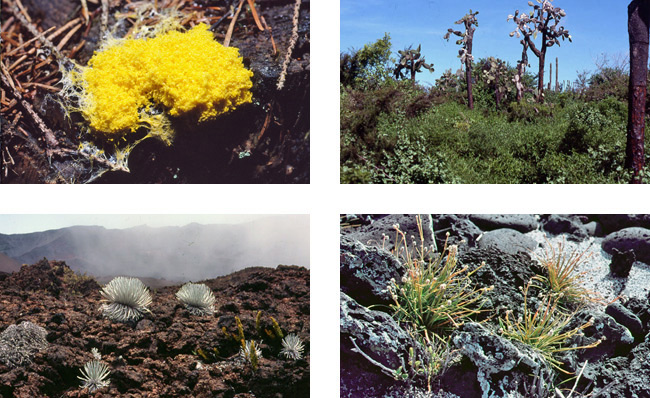
Research interests (abstracts)
- Myxomycetes, plasmodial slime moulds
Myxomycetes or acellular slime moulds are eukaryotic heterotrophic organisms that are neither plants nor fungi. Spores germinate to an amoeba or a flagellated stage. Amoebae fuse to a diploid cell that grows to a multinucleate motile plasmodium that may be several cm across. Eventually the plasmodium transforms into one or several spore-producing fruitbodies. Myxomycetes are common in soil and on various debris all over the world. The amoebal stage probably plays an underrated ecological role in soil. Read more >>
- Island Biogeography
(a) Flora of the Galápagos Islands
Phytogeographically the Galápagos is strongly allied to the South American mainland from where about 70% of the indigenous flora is derived. About 32% of the indigenous vascular plant species are endemic. The islands exhibit several beautiful examples of adaptive radiation among plants as well as animals. Read more >>
(b) Hawaiian Islands; patterns of plant evolution
Hawaii is a prime example of an oceanic archipelago, a chain of islands that have arisen through volcanic activity on the ocean floor and have never been connected to a continent. Characteristic features of an oceanic archipelago beautifully illustrated in Hawaii are (1) disharmonic biotas, (2) high endemism among animals and plants, (3) adaptive radiation in many groups of organisms and (4) vulnerability to introduced animals and plants. Read more >>
- The Amaranthaceae and related families in the Neotropics and the Pacific
The Amaranthaceae is one of the core plant families in the Caryophyllidae and probably comprises some 800-900 species. The family is most richly represented in arid and semi-arid habitats. Twenty-three genera occur in the New World and the Neotropics. Different subfamilies of the Amaranthaceae have differentiated in the Galápagos and the Hawaiian Islands and in both archipelagos endemic taxa exhibit a wide range of variation. Read more >>
UNO ELIASSON

University affiliation:
University of Gothenburg
Department of Biological and Environmental Sciences
Email:
uno.botan@gmail.com
Scientific publications:
Click here (pdf) >>